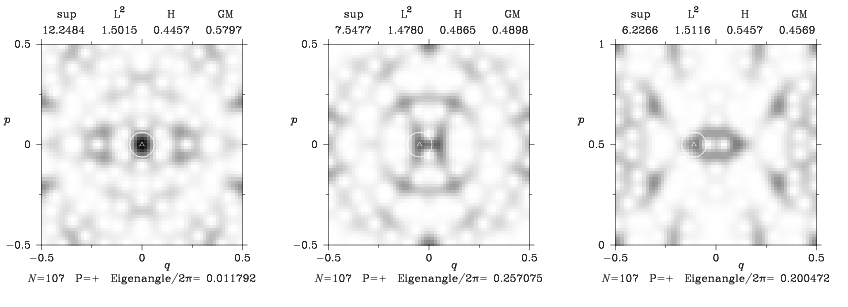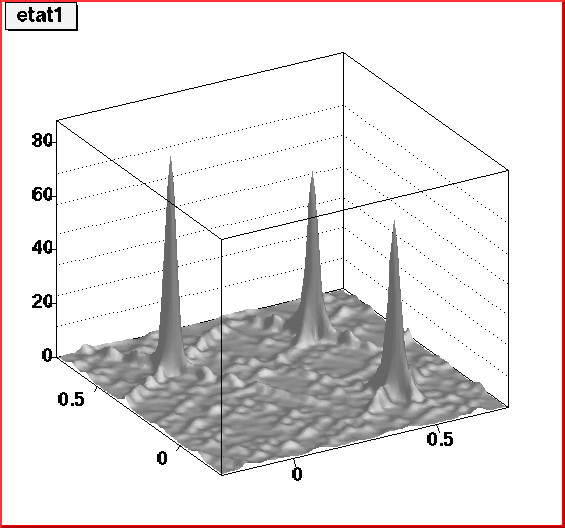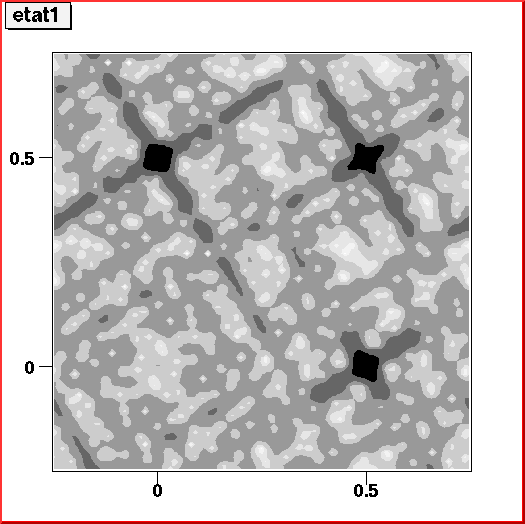
Quantum chaos
|
||||||
|
Quantum
chaos? Let
us consider the quantization of an autonomous Hamiltonian of a closed
system (the spectrum is purely discrete). Quantum chaos (or "chaology") deals with the semiclassical behaviour of quantum quantities, in the case where the classical limit of the Hamiltonian is chaotic, or at least non-integrable. For
a generic Hamiltonian in 2 or more degrees of freedom, one has in general
very bad knowledge of the quantum invariants (eigen-values and vectors).
The only solvable case is the textbook example of a quantum integrable
system, where the Hamiltonian belongs to a family of d commuting
operators. The system can then be reduced to a seris of 1-dimensional
quantum systems, the spectrum of which can be approximately computed
using the Bohr-Sommerfeld-WKB method. This corresponds to solving an
ordinary differential equation (which is doable), as opposed solving
to a genuine partial differential equation (which is not). One of the aims of quantum chaos is to better understand the spectrum (eigenvalues/vectors) of such non-solvable quantum systems, especially in the semiclassical limit, and when the classical limit system is chaotic. Equivalently, it asks the following question:
In the classical framework,
the simplest chaotic conservative systems are maps on 2-dimensional
phase spaces, like the 2-torus. Since such a map can be understood as
a stroboscopic version of a Hamiltonian flow, it is natural to quantize
it into a "quantum propagator", that is a unitary operator on the corresponding
Hilbert space. A compact phase space (like the 2-torus) leads
to finite-dimensional quantum Hilbert spaces: the quantized
maps are unitary matrices, which can be easily (numerically) diagonalized. Eigenstates of
quantum chaotic maps To study the semiclassical structure of the eigenstates of such quantum maps, it is convenient to represent these states in phase space, instead of simply as N-dimensional vectors. I focussed on the so-called Bargmann-Husimi representation, which associates to any quantum state a positive function on the torus, called its Husimi density.
A first answer
to this question concerns all ergodic systems (map or Hamiltonian flow),
and is called the property of This convergence
does not prevent the Husimi function to strongly fluctuate at small scales
(it necessarily vanishes at N points of the torus). Looking at
the above plots (especially the left one), we see some enhancement
of the Husimi density on the origin, which is a hyperbolic fixed
point of the classical map. Such enhancements, first discovered on eigenstates
of chaotic billiards, are called scars of the periodic orbit.
The precise definition of a scarred state is problematic: scarred states
still (weakly) converge to the uniform measure; on the other hand, the
Husimi density of a random state also fluctuates, but its enhancements
can take place anywhere on the torus. Furthermore,
there remains the question of possible exceptional sequences
of eigenstates for which the Husimi densities converge to a different
measure (e.g. a delta measure on a periodic orbit). A negative answer
to that question is called the Quantum Unique Ergodicity
(all eigenstates converge to the Liouville measure). Most people believe that
a generic Anosov system satisfies this property.
The cat map
is not a "generic" Anosov map, due to its linearity. As a consequence,
the distribution of its eigenvalues is very different from those of a
random unitary matrix (in particular, they can be very degenerate). The
strong scarring also seems related with the
high degeneracies of the eigenvalues.
|



